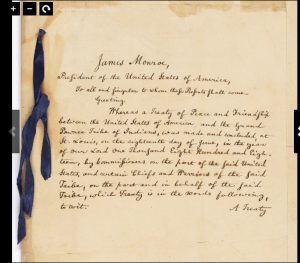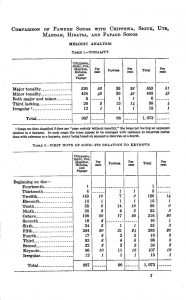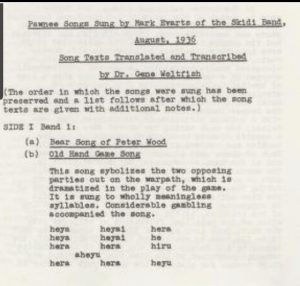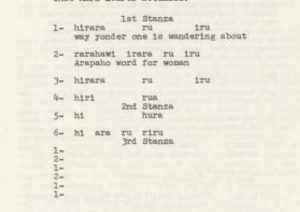When one thinks of Native American music, what comes to mind? For me, I think of powwows which consist of dancing and music and fancy regalia. I additionally think of bison burgers and jewelry buying stations (where I still own a piece I bought 10 years ago). My experience, however, is not the full truth.
Frances Densmore, a name popular in the musicology world for studying Native American music, was one of the first people to attempt to understand more about the world of Native American music. In 1919-1920 (not too long ago), Densmore conducted a study among members of the Skidi and Chaui Bands near Pawnee, Oklahoma. 1 The first treaty between specifically Pawnee and the Government was in 1818 with the Ratified Indian Treat 92: Grand Pawnee – St. Louis, June 18, 1818.
Ratified Indian Treat 92: Grand Pawnee – St. Louis, June 18, 1818.2
With this treaty, it felt that Natives were becoming more known about and taken into account for living in the United States. But some would say how problematic it would still become. The chart below documents the tonality and takes into account the first note and how that affects the key of the melody.
However helpful this may be to the Western culture in understanding the first hearings of Native American music. It almost disrespects their culture and tradition. It is not ethical or right to fully understand and teach others about Native music through a Western Lens then it would be for Natives to teach classical music through a Native American Lens. It’s like teaching an animal to read a book!
A study done by Mark Evarts, published in 1967, shows a different type of notation after hearing Native American melodies.3 For example, the first melody is titled “A Bear Song of Peter Wood” and “Old Hand Game Song” and explains the story behind these songs by analyzing through explanation with only a bit of notation. Evarts writes that the song symbolizes two opposite parties in war which is acted out emotionally and song on “meaningless” syllables. Evarts says meaningless but how do we know it is or isn’t? He writes the words below and attempts to show the song in stanzas. I believe it is better notation than completely composing it to look Western-styled.
Overall, I feel that as society progresses, the understanding of other cultures’ music will continue to grow with respectful and helpful learning. We have to be able to understand through two different perspectives, ours and theirs, to get as complete of a picture as possible. We will not always be able to understand the meaning or why one part of the song says a certain word, but we can treat them as humans.
1 Frances Densmore, Pawnee Music (New York: Da Capo Press, 1972 [1929])
2 Ratified Indian Treaty 92: Grand Pawnee – St. Louis, June 18, 1818. The Indigenous Digital Archive. https://digitreaties.org/treaties/treaty/162559362/
3 Evarts, Mark. “Music of the Pawnee – Sung by Mark Everts. Internet Archive. (Folkways Records; Kahle-Austin Foundation, 1967).





